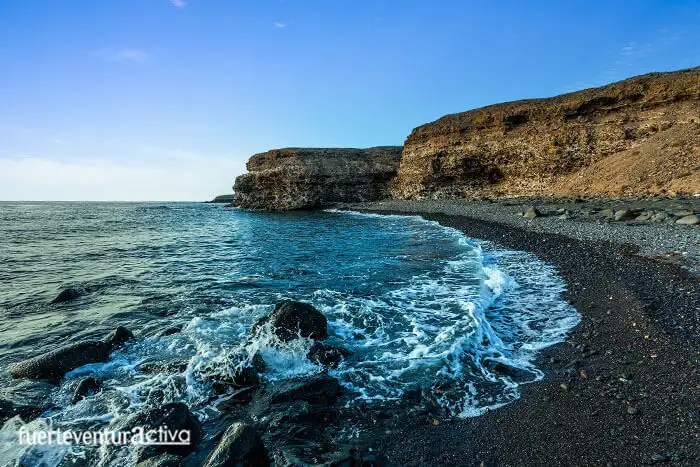Routes and trails
Bike route: Playa de la Guirra – Pozo Negro
Pedaling through the Majorero landscapes is one of the best ways to explore Fuerteventura. It allows you to discover, at your own pace, the wonders that the island offers you, especially its coast.
Today we propose an itinerary of about 9 kilometers full of history and charming corners. The route will take you, with little effort, from Guirra beach, in Caleta de Fuste, to Pozo Negro.
History of the route Playa de la Guirra – Pozo Negro
Both Caleta de Fuste and Pozo Negro, two coastal towns in Antigua, have been fundamental in the commercial development of Fuerteventura.
For a long time, the easiest way to go from Pozo Negro to Caleta de Fuste was to go along the coast, just along the path that we are traveling today.

Caleta de Fuste was an important maritime port. Ships loaded with salt have left here for centuries to other island destinations. On the Guirra beach there are still centenary lime kilns
Pozo Negro, for its part, has played a prominent role as a freight port. During the conquest of Fuerteventura (1402 – 1404) the port of Pozo Negro welcomed the Franco-Norman ships loaded with soldiers, weapons and food. When the conquest ended, Pozo Negro became a stable settlement, and its port was considered one of the most important for the entry of food. This relevance lasted well into the 19th century.
In the beginning, this historic trail that runs along the coast was much narrower and more winding. It was wide enough for a pair of camels with their load to pass through. Currently the road is suitable both to travel in 4 X 4 and to do it on foot or by bike. This is due to the fact that it was remodeled for vehicle traffic in 1941, with prison labor, specifically by the Disciplinary Battalion of Sentenced Workers Soldiers No. 91. These same prisoners raised the various Bunkers that we will see throughout the tour.
Points of interest from Playa de la Guirra to Pozo Negro
The Guirra lime kilns are an excellent meeting point from which to start the route. It has a large parking lot in the shopping center behind it, where you can also buy some supplies, if you need it.
The lime kilns of La Guirra

It is a set of three lime kilns, a warehouse and the house-house of the lime trees, as well as a cistern with a capacity of about 300 cubic meters. The Guirra lime kilns date from the 18th century, they are of an industrial type, circular, with a staggered frustoconical development, with large masonry walls two or three meters thick and covered with refractory brick. They were in operation until the middle of the 20th century.
La Guirra Paleontological Site

Just 500 meters from the start of the route, heading south, we find the first stop. It is the Paleontological Site of La Guirra. Here, by the sea, you will have the opportunity to see a good number of marine fossils. For the most part they are shells and mollusks from the Pleistocene, but there are also more recent ones, from the Holocene, with an estimated age of 4,000 years.
Salinas del Carmen and Salt Museum.

Las Salinas del Carmen is the next historical landmark that we will see on this tour. It is located about 3 kilometers south of Caleta de Fuste, in front of a spectacular sea level, used, since time immemorial, to catch fish at low tide.
The Salinas del Carmen date from the end of the 18th century. Tons of sea salt have been extracted from them and they were in operation without interruption until the middle of the 20th century. After a few decades of neglect, public institutions acquired the salt flats, making this enclave a museum. Here the Salt Museum was installed.
In 2016 the facilities were modernized, putting the salt flats back into service. The salt extracted from the Salinas del Carmen is of great quality. It has obtained several awards that endorse it as the Best Marine Salt of the Canary Islands.
Puerto de la Torre beach

We continue our journey towards Pozo Negro. Next stop: Puerto de la Torre beach.
This beach of just over 200 meters in length and a width of about 5 meters, is located at the mouth of the La Torre ravine.
This part of the Majorero coast is a natural port used since the 15th century. It served as an entrance for merchandise and anchorage for ships, in whose holds the lime was loaded, coming from the nearby kiln.
The beach is made up of pebbles and rocks. It is one of the favorite enclaves for those who like angling, but also for those who seek the tranquility of the night.
Caleta de la Ballena, Majada de las Cabras Beach, Caleta Blanca and Leandro Beach

From Puerto de la Torre Beach to Pozo Negro we find four wonderful secluded horseshoe-shaped coves, which are La Playa de Majada de las Cabras, Caleta de la Ballena, Caleta Blanca and Playa Leandro.
They are protected from the prevailing winds by small rocky cliffs. Its soils are composed of rocks and pebbles.
All of them are ideal for surface diving or snorkeling, where you can see salema, pejeverde, fulas, spider fish, viejas, etc.
Pozo Negro

The end of our route is in Pozo Negro, a charming little coastal town currently dedicated to inshore fishing, goat farming and tourism.
In Pozo Negro there are a couple of restaurants whose specialty is paellas and fresh fish. In addition, it has the only camping area in Antigua, with 72 places for the temporary installation of huts, caravans or similar, and a hostel with a capacity of 60 places.
Near Pozo Negro is the Poblado de la Atalayita, an enclave that you cannot miss.
Fuerteventura2




